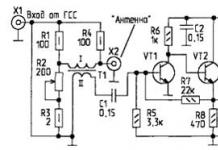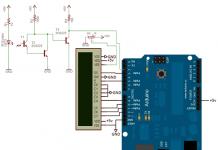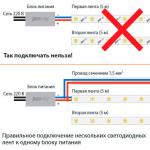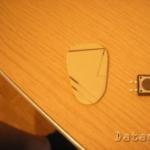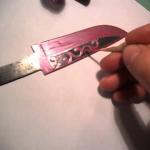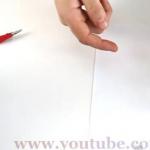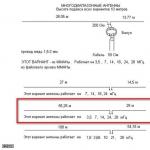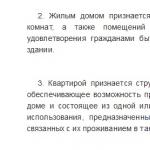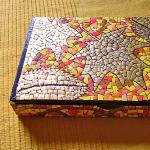One fine day I needed to wind the coils, and the question immediately arose of how to count the turns, but I didn’t want to count in my head. So the idea came to build a counter from a calculator.
To do this, I needed a Chinese calculator lying idle, a button, a couple of wires and a cam made from a piece of plastic to press the button.
Please don’t laugh at the so-called “machine”: I rarely wind reels, I don’t even know when the next time will be. Therefore, I put everything together hastily and did not bother with anything grandiose.
A couple of corners, a threaded rod, nuts, washers of different sizes - all this is available in abundance at the nearest fastener store at very affordable prices.
The rod with the coil frame rotates freely in the holes of the corners.
An obvious improvement for regular use - it suggests itself reed switch instead of a mechanical button and magnet on the fist. Let's get a contactless speed sensor.

Manufactured plastic cam and discovered tact button.

We solder the wires to the terminals of the [=] button (they need to be found and cleaned on the calculator),
and the other ends to the button.

The result is a design like this:
When winding the first turn, set the cam to trigger the button
On the calculator we type

We start winding, the cam goes through a revolution and presses the button, the number 1 lights up on the calculator,
And so on: with each revolution, 1 is added.
1+1=2
2+1=3…
This is what happens gradually:
In amateur radio practice, there is often a need to wind/rewind various windings of transformers, chokes, relays, etc.
When developing this machine, the following tasks were set:
1. Small dimensions.
2. Smooth spindle start.
3. Counter up to 10,000 turns (9999).
4. Winding with automatic wire laying. Laying pitch (wire diameter) 0.02 - 0.4mm.
5. Possibility of winding sectional windings without reconfiguration.
6. Possibility of fastening and winding frames without a central hole.

Picture 1.
External view of the winding machine.
Composition of the winding machine.
1. Feed reel (reel of wire).
2. Braking (brake mechanism).
3. Stepper motor for bobbin centering.
4. Ball furniture guides.
5. Shutter of optical sensors of the reel centering mechanism.
6. Handle for moving the positioner to another section when winding sectional windings.
7. Buttons for manually switching the laying direction.
8. LEDs for laying direction.
9. Positioner stepper motor.
10. Shutters of optical winding boundary sensors.
11. Positioner screw.
12. Ball furniture guides.
13. Winding reel.
14. Winding motor.
15. Turn counter.
16. Setting buttons.
17. Optical synchronization sensor.
18. Speed controller.
Device and principle of operation.
Feeding unit.
The feeding unit is designed to attach a reel of wire of various sizes to it, and provide tension on the wire.
It includes a bobbin fastening mechanism and a shaft braking mechanism.

Figure 2.
Feeding unit.
Braking.
Without braking the feed reel, the winding of the wire on the frames will be loose and high-quality winding will not work. Felt tape “2” slows down drum “1”. Turning the lever “3” tightens the spring “4” - adjusting the braking force. For different wire thicknesses, its own braking is adjusted. Off-the-shelf VCR parts are used here.

Figure 3.
Braking mechanism.
Bobbin centering.
The small dimensions of the machine and the location in close proximity of the winding reel and the feed reel with wire required the introduction of an additional mechanism for centering the feed reel.


Figure 4, 5.
Centering mechanism.
When winding the coil, the wire from the reel acts on the shutter “5”, made in the form of a “fork” and the stepper motor “3”, through a gearbox with division 6 and a toothed belt, along roller guides “4”, automatically moves the reel in the desired direction.
Thus, the wire is always in the center, see Fig. 4, Fig. 5:

Figure 6.
Sensors, rear view.
Composition and design of sensors.
19. Optical sensors for the bobbin centering mechanism.
5. A curtain covering the sensors of the reel centering mechanism.
20. Curtains covering the positioner direction switching sensors.
21. Optical sensors for switching the direction of the positioner.
Positioner.
Curtains “20” fig. 6 - the winding limit is set. The stepper motor moves the stacker mechanism until the curtain blocks one of the sensors “21” fig. 6, after which the laying direction changes.
You can change the laying direction at any time using buttons “1” fig. 7.

Figure 7.
Stacker.
Rotation speed of stepper motor “9” fig. 7, synchronized using sensor “10”, “11” Fig. 8, with the rotation of the wound coil and depends on the diameter of the wire set in the menu. The wire diameter can be set to 0.02 - 0.4mm. Using knob “8” fig. 7, you can move the entire positioner to the side without changing the winding boundaries. In this way, it is possible to wind another section in multi-section frames.

Figure 8.
Optosensor.
Composition of the positioner and opto-sensor (Fig. 7-8).
1. Buttons for manually switching the laying direction.
2. LEDs for laying direction.
3. Curtains covering the positioner direction switching sensors.
4. Linear bearing.
5. Caprolon nut.
6. Lead screw. Diameter 8mm, thread pitch 1.25mm.
7. Ball furniture guides.
8. Handle for moving the positioner to another section when winding sectional windings.
9. Stepper motor.
10. Optical timing sensor.
11. Disk covering the synchronization sensor. 18 slots.
Receiving node.

Figure 9.
Receiving node.


Figure 10, 11.
Receiving node.
1. Turn counter.
2. Commutator high-speed motor.
3. Reducer gear.
4. “Counter reset” button.
5. Speed adjustment.
6. “Start winding” switch.
7. Fastening of the winding reel.
The rotation of the wound coil is produced by a high-speed commutator motor through a gearbox.
The gearbox consists of three gears with a total pitch of 18. This provides the necessary torque at low speeds.
The motor speed is adjusted by changing the supply voltage.


Figure 12, 13.
Fastening a frame with a hole.
The design of the receiving unit allows you to fasten both frames with a central hole and frames without such holes, which is clearly visible in the figures.


Figure 14, 15.
Fastening a frame without a hole.
Electrical diagram.

Figure 16.
Electrical circuit of the winding machine.
All processes of the machine are controlled by a PIC16F877 microcontroller.
Indication of the number of turns and diameter of the wire is displayed on a four-digit LED indicator. When the “D” button is pressed, the diameter of the wire is displayed; when pressed, the number of turns is displayed.
To change the wire diameter, press the “D” button and use the “+”, “-” buttons to change the value. The set value is automatically saved in the EEPROM. Button “Zerro” - resets the counter. The “ISCP” connector is used for programming the microcontroller.
P.S. There are no mechanical drawings because the device was manufactured in one copy, and the design was formed during the assembly process.
In this design, disassembled elements and assemblies (not marked) from VCRs and printers were used.
In no case do I insist on the exact repetition of this design, but only on the use of any nodes from it in my designs.
Reproduction of this device is possible by experienced radio amateurs who have skills in working with mechanics and are able to change the design to suit their existing mechanical parts.
The mechanical part, accordingly, can be implemented differently.
Gearboxes on engines may have a different division.
Critical elements:
For the program to work correctly, a number of conditions must be met, namely;
Optical sensor “17” Fig. 1., may be of a different design, but must have 18 holes.
The positioner screw must have a pitch of 1.25 mm - this is a standard pitch for a screw with a diameter of 8 mm.
Positioner stepper motor 48 steps/revolution, 7.5 degrees/step - these are the most common motors in office equipment.
Demonstration video of the machine:
Below in the attachment (in the archive) all the necessary files and materials for assembling the winding machine are collected.
If anyone has any questions regarding assembly and setup, please ask them on the forum. I will try to answer and help if possible.
I wish you all good luck in your creativity and all the best!
Archive "Winding machine"
After reviewing a number of designs of counters for various purposes published in the magazine (for example, ), I decided to develop my own version of a turns counter, which uses the non-volatile memory of a microcontroller. As a result, it was possible to create a simple and easy-to-use winding counter for a winding machine that does not contain scarce parts.
Rice. 1
The counter consists of several nodes ( rice. 1). The basis of the design is the DD1 microcontroller, to which a four-digit LED indicator HG1 is connected through current-limiting resistors R10-R16. Two optocouplers - an IR emitting diode-phototransistor (VD2VT1, VD3VT2) - forming a speed sensor for the working shaft of the machine, generate low-level pulses, from which the microcontroller determines the direction of rotation and the number of shaft revolutions. There is an SB1 button for resetting the memory, as well as auxiliary circuits: R2C2, which operates as part of the microcontroller’s built-in clock generator, VD1C1, which maintains the supply voltage necessary to switch the microcontroller to SLEEP mode, and R6R8, which monitors the meter’s supply voltage.
It is known that microcontrollers of the PIC family are quite capricious when working with EEPROM (especially when writing to it occurs automatically). Reducing the supply voltage can distort the contents of the memory When the counter is operating, line RB1 (pin 7) of the microcontroller, to which the R6R8 circuit is connected, is polled for the presence of supply voltage, and if it disappears, then thanks to the VD1C1 circuit, the microcontroller manages to go into sleep mode, thereby blocking further program execution and protecting information in EEPROM. During the counting process, the microcontroller will store numbers in memory after each revolution of the machine's working shaft. Each time the power is turned on, the HG1 indicator will display the number that was before the shutdown.
The sensor is a small printed circuit board (22x22 mm), on which two emitting diodes and two phototransistors are mounted, installed so that they form two optical transmitter-receiver channels. The optical axes of the channels are parallel, the interaxial distance is about 10 mm.
A shutter in the form of a disk made of hard material (textolite, getinax, metal, plastic) opaque to IR rays with a thickness of 1...2 mm is fixedly fixed on the working shaft of the machine. The diameter of the curtain is 35…50 mm, the diameter of the central mounting hole is equal to the diameter of the shaft. The board is fixed on the machine so that the curtain, rotating with the shaft, can block both IR beams.
A cutout in the shape of an incomplete sector is cut into the curtain. The angular width and depth of the cutout must be such that when the shaft rotates, the shutter allows short-term passage of IR radiation, first through only one channel, then through both, and finally only through the other, as is schematically illustrated in rice. 2. Channels that are open in one position or another are shown in color. This order of signals from the sensor gives the microcontroller the ability to determine the direction of rotation of the working shaft of the machine.

The meter is powered by a battery of three AA galvanic cells (R6), but you can use any network unit with a stabilized output voltage of 5 V.
Instead of “surface” resistors, you can use MLT-0.125 or S2-23 with a power of 0.062 W. Button SB1 - any button suitable for the mounting location on the board. Instead of E40281-L-O-0-W, the digital indicator FYQ-2841CLR is suitable.
The microcontroller program was developed and debugged in the Proteus environment, after which it was loaded into the microcontroller using the ICProg programmer. After installing the microcontroller in the panel, the first and subsequent times the meter is turned on, the indicator will display a minus sign in all familiar locations. After about two seconds, zeros will appear on the display - this is a sign that the meter is ready for operation.
The program provides an emergency memory reset function in case it receives erroneous information and the microcontroller freezes (this happens extremely rarely, but it can happen). To return the microcontroller to operating mode, you need to turn off the power to the meter, press the “Reset” button and, without releasing it, turn on the power. As soon as the display displays zeros, you can continue to work, but information about the previous number of turns will, of course, be lost.
A properly assembled device does not require any adjustment.
LITERATURE
1. Dolgiy A. Improved reversible counter. - Radio, 2005, No. 11, p. 28, 29.
2. Gasanov A., Gasanov R. Electronic meter. - Radio. 2006, no. 11, p. 35, 36.
A. BANKOV, Orel (Radio, No. 8 2011)
In the work of radio amateurs and electricians, devices for winding copper wire with a diameter of 1.5 mm onto a special electric coil are useful. In an industrial setting, this process requires speed and precision. Home craftsmen can reproduce this technology. To do this you will need a homemade winding machine. It is characterized by the following symptoms:
- ease of creation and operation;
- possibility of using different transformers;
- availability of additional functions: counting the number of wire coils.
Winding machine operating method
A winding machine is a popular equipment with which transformer single-layer and multilayer cylindrical coils and all kinds of chokes are wound. The winding device evenly distributes the winding wire with a certain tension level. It can be manual or automatic, and works on the following principle:
- Rotation of the handle sets the winding of the wire or cable onto the coil frame. It serves as the base of the product and is put on a special shaft.
- The wire moves horizontally thanks to the guide element of the stacker.
- The number of turns is determined by special counters. In homemade designs, this role can be played by a bicycle speedometer or a magnetic reed switch sensor.
The manual device for laying wires is quite primitive, so it is rarely used in production.
A mechanically driven winding machine allows you to perform complex winding:
- private;
- toroidal;
- cross.

It operates using an electric motor that drives the intermediate shaft using a belt drive and three-speed pulleys. The friction clutch plays a big role in this. Thanks to it, the machine operates smoothly, without shocks or wire breaks. A spindle with a fixed frame, on which a coil is placed, starts the counter. The winding machine is adjusted using a screw to any width of the reel frame.
Modern models are equipped with digital equipment. They work through a specially defined program that stores information in a storage device. The value of the length and diameter of the wire allows you to accurately determine the point of intersection of the lines.

Winding machine mechanism
The winding machine is classified into groups:
- private;
- universal;
- toroidal winding.



Each product has an individual design.
A winding machine that performs row laying of wire consists of the following elements:
- The winding mechanism has the form of a welded frame, which is equipped with a motor, a toothed belt drive, a headstock and a tailstock.
- The layout mechanism allows you to move long material along the winding axis. This is a welded structure along which a carriage with guide rollers for the wire moves.
- Device models differ from each other in size and functionality.

The standard model of a device for laying wires with several bends in one turn assumes the presence of the following elements:

- The main frame, consisting of wooden or metal posts that occupy a vertical position.
- Between the supports there are two horizontal axes: one for the plates, the other for the coil.
- Replaceable gears that send rotation to the reel.
- The handle that rotates the reel axis. A collet clamp is used to secure it.
- Fasteners: nuts, screws.
Winding of wire onto toroidal cores is carried out using specialized ring-type equipment:
- The device looks like a shuttle, working on the principle of a sewing needle.
- The spool is a mechanism of two intersecting rings with a removable sector on which a toroidal frame is installed.
- The rotation of the spool is set by an electric motor.

Necessary materials and equipment for manufacturing
To make your own machine for winding wire on a round frame, you will need several parts.
The frame is made of sheet material, fastened by welding. The optimal thickness of the base is 15 mm, the side parts are 6 mm. The stability of the structure is ensured by its heaviness:

- The side parts are placed next to each other, and holes are drilled into them at the same time.
- The prepared elements are welded to the base.
- Bushings are installed in the high holes, and bearings are installed in the lower ones, which can be taken from a used disk drive.
- Fasteners on the outside of the sidewalls are securely fixed with lids.
Important components of the machine design are shafts:
- The upper shaft with a diameter of 12 mm holds the reel frame. Its role can be played by a similar structural part of a failed dot matrix printer.
- The feeder for long material rests on the middle shaft of the same diameter. It is advisable to polish it before putting it into operation.
- The lower shaft is the feed element. Its dimensions depend on the thread pitch.

The stacker sleeve has a diameter and length of 20 mm. Its internal thread matches the thread of the lower shaft.
The pulleys are three-stage, machined from steel, with a total thickness of no more than 20 mm. Otherwise, you will have to increase the shanks of the upper and lower shafts. Each block contains three grooves with different diameters, depending on the cross-section of the wire. Their width is determined by the belts. This combination provides a wide variety of wire winding steps.
Wire laying device
Laying and winding of wire is carried out using three plates fastened together with screws with a diameter of 20 mm. A small 6 mm hole is made in the upper part, where the tension adjustment screw is inserted:
- PTFE and steel bushings with a diameter and length of 20 mm are mounted in the upper and lower parts of the inner plate.
- A leather groove up to 2 mm thick is glued between the outer elements, which is necessary for aligning and tensioning the coil wire.
- A special threaded rod or mini-clamp is mounted at the top of the stacker, which fastens the outer plates and regulates the tension. The fastening distance depends on the diameter of the wire.
- For ease of operation, the design is additionally equipped with a folding bracket for the reel.

Manufacturing of turns counter
To determine the number of wound turns on the machine, a special counter is needed. In a homemade machine, the device is made like this:

- An electromagnet is attached to the upper shaft.
- The sealed contact is located on one of the sidewalls.
- The output contacts of the reed switch are connected to the calculator in the place where the “=” button is located.
- The coil with the wire is placed separately - on another shaft with levers that lift the device up and fold it inside the machine.
Thanks to these elements, the equipment becomes compact and does not take up much space.
Operating principle of the machine
It is not difficult to work on the designed machine. The technological process requires certain actions:
- The upper shaft is prepared for work: the pulley is removed, the required length of the coil frame is set, and the right and left disks are installed.
- A fastener is inserted into the hole in the upper shaft, centered and the frame is clamped with a special nut.
- The required pulley for the primary winding is mounted on the feed shaft.
- A stacker is installed opposite the reel frame.
- The belt is placed on the pulleys in a ring or figure eight, depending on the type of installation.
- The metal wire is inserted under the additional shaft, placed in the groove, and secured.
- The wire tension is adjusted using clamps located at the top of the stacker.
- The wire should be wound tightly around the base of the coil.
- The numerical value “1+1” is recorded on the calculator.
- Each revolution of the shaft adds a given count.
- If the turns need to be rewinded, press “–1” on the computing device.
- When the wire reaches the opposite part of the frame, use a collet clamp to change the position of the belt.
For different thicknesses of metal wire, the pulley is correlated with the winding pitch.
For all radio amateurs or enthusiasts interested in sound-reproducing equipment, a winding machine is an extremely popular piece of equipment. Such devices are used for winding single-layer and multi-layer cylindrical coils for transformers.
In this article we will study the design and operating principle of a winding machine, and also consider step-by-step instructions, following which you can make such equipment with your own hands.
1 Design and principle of operation
The winding machine is indispensable in the production of similar products. There are two types of such units - automatic and manual, while the latter are practically not common in the industrial sector due to limited functionality.
However, the overall dimensions, heavy weight and cost of automatic winders make them inapplicable in everyday life, so it is better to get a manual machine for your home. The standard design of such a device consists of the following elements:
- a supporting frame made of two vertical posts made of metal or wood, between which horizontal axes are fixed (on the central post - for the plates with a wheel, on the outer one - for the coil itself);
- large and small gears that transmit torque to the reel;
- a handle fixed on a large gear, through which the axis with the reel rotates;
- fastening elements - screws and nuts.

The principle of operation of such a device is extremely simple - rotating the handle leads to winding a wire or cable onto a rotating frame; the stacker guide, which moves the wire in a horizontal plane, is responsible for the uniformity of winding.
Monitoring the number of turns can be done both visually and using special counters, the simplest of which is a regular bicycle odometer. In more advanced machines, a special magnetic reed sensor is used as a counter.
1.1 Magazine machines
Among industrial winding units, the cable winding machine SRN-05M3 is widely popular. This model was put into operation during the Soviet era, and since then has proven itself well due to its high reliability and performance. On the secondary market, SRN-05M3 can be found for 15-20 thousand rubles.

SRN-05M3 is made of cast iron, the weight of the equipment is 80 kg, the dimensions are 877 * 840 * 142 cm. The machine allows you to wind single-layer, double-layer and toroidal coils in automatic laying mode. The minimum cable diameter is 0.05 mm, the maximum is 0.5 mm. The unit is equipped with a single-phase electric motor of the UL-62 type, the power of which is 0.18 kW. The highest rotation speed during winding is 5100 rpm.

For household use, the best choice would be a manual machine NZ-1 (China). Despite the country of origin, the NZ-1 is quite reliable and functional equipment. The unit is designed for winding coils with a diameter of up to 150 mm, with a maximum width of no more than 100 mm. The gear ratio is 1:08 in fast winding mode and 1:0.1 in slow winding mode. Maximum speed - no more than 1000 rpm.
NZ-1 is equipped with a mechanical type thread counter. The body is made of metal, the supporting frame is made of cast iron. The machine is equipped with a pulley, which allows you to connect an electric motor to it via a belt drive and operate in automatic mode. The cost of such equipment varies between 4-5 thousand rubles.
1.2 Homemade winding machine (video)
2 Making a winding machine with your own hands
The cable winding machine presented in this section of the article allows you to work with coils on a square, round and rectangular frame with a diagonal of up to 200 mm; it can be equipped with different pulleys, which will allow you to change the winding pitch within 0.3-3.2 mm.

The diagram below shows the frame of the machine. To assemble the frame, metal sheets with a thickness of 15 mm (for the base) and 5 mm (for the side sections) are used. Saving on metal thickness is not welcome, as it leads to a decrease in the weight of the unit and, as a result, a deterioration in its stability.
You will need to cut out the frame blanks (the dimensions are respected) and drill two through holes in them, then the sides are welded to the base plate. You need to mount 2 bearings in the lower hole, and bushings for the rotation shaft in the upper hole.

As a shaft, you can use a 12 mm smooth reinforcement bar, which must first be sanded and painted. For the stacker sleeve, you can take a rod with a diameter of 10 mm, along the entire length of which a thread of standard M12 * 1.0 is cut.

It is better to make triple pulleys, but keep in mind that their total thickness should not exceed 20 mm. With greater thickness, it will be necessary to additionally increase the length of the shafts by a similar size. The combination of pulleys indicated in the diagram allows the use of 54 different winding steps. If you need to work with wires with a diameter of less than 0.31 mm, you will need an additional 12/16/20 mm pulley, with which you can wind 0.15 mm wires.

To construct a manual drive, you will need a large gear and handle, which are fixed by means of a collet clamp on the upper shaft. Thanks to the use of a collet, you can, if necessary, interrupt the winding by fixing the handle, thereby preventing the reel from unwinding.
The thread counter for the winding machine is made from a regular calculator. You will also need a magnet with a reed sensor (can be bought at any radio equipment store), the leads of which must be connected to the contacts of the calculator on the “=” button.
2.1 How to work on a homemade machine?
So, the equipment is ready, how to work on it? To install the winding frame, it is necessary to extend the upper shaft from the mounting socket to a length equal to the length of the frame. Next, the right disk and the coil mandrel are mounted on the shaft, on top of which the coil itself is put on. The next step is to install the left disk and screw on the nut, after which everything is installed in its original position.

A nail is placed in the hole on the upper shaft and the frame is centered, after which the frame is clamped with a nut. Further operations are performed in the following sequence:
- A pulley of suitable diameter is placed on the feed shaft.
- By rotating the pulley, the stacker moves to the extreme position, to one of the sides of the reel.
- A wire belt is put on the pulley - in a ring or figure eight. The end of the wire must be threaded under the middle shaft, placed in the stacker chute and secured to the frame. The wire tension is adjusted using clamps on the handler.
- At the beginning of winding, the combination “1+1” is typed on the calculator, after which the handle is rotated. With each full revolution of the shaft, the calculator will independently increase the number on the screen by one, thereby counting the number of turns of the wire.
Since this equipment has an extremely simple device that does not have any kind of winding machine control controller, during operation you will need to constantly monitor the reel and, if necessary, adjust the cable on the frame manually.

If you want to make the machine more functional, you will need to complicate the design by adding a controller to it. This will allow you to automate the workflow, however, for fully mechanical pairing, you need to install a stepper motor in the controller (a regular 24-volt drive operating in 44-60 steps per revolution mode will do). Power transistors for this kit are selected based on the characteristics of the motor. The ATmega8 device is ideal as a controller; you can buy it for 150-200 rubles.
